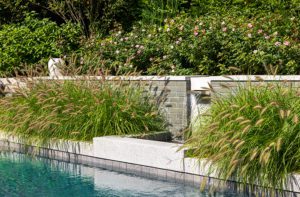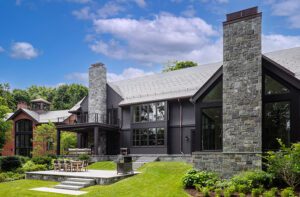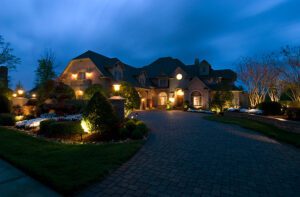Always in Season
August 29, 2012
Text by Stacy Kunstel Photography by Eric Roth Produced by Karin Lidbeck Brent
While most everyone else on the Cape is covering the wicker with sheets and lowering the blinds on yet another summer, one couple on Buzzard’s Bay is arranging wood for the fire and getting ready for their favorite season in their waterfront home.
This house wears no florals or chintz to recall hot July days as the shadows grow longer; rather, an all-season calm carries its owners into the winter months.
As graduate students in the 1980s, the couple rented this very Woods Hole house for a winter. Years later, after they’d bought their own nearby home, they were on a walk when they spied their old winter rental—its wide porches and dark wood interiors unchanged—for sale.
“The living room, dining room and porch all face Buzzard’s Bay and look much as they did when we first stayed there,” says the homeowner. “The upstairs had been carved into tiny bedrooms and the house was a bit like a rabbit warren in the front.”
But the home still had the dark heart-pine floors they had loved and, despite the preaching of magazines and television shows to just paint it white, the old beadboard throughout the rooms had never felt a brush.
The house needed work, but the couple wanted to retain the spirit they recalled from years earlier. Having worked with architect Lynn Hopkins before, they contacted her to help them clear the cobwebs. Boston-based Payne/Bouchier, known for their exquisite woodwork and attention to craftsmanship, joined the team as the contractor while Cheryl and Jeffrey Katz of C&J Katz Studio in Boston consulted on the overall design and completed the interiors.
“We chose to keep it like it was, with a dark interior that contrasts with the bright light outside,” says Hopkins, whose architectural firm is based in Lexington, Massachusetts. Even the large glassed-in porch across the back of the house, despite its uninterrupted ocean view, seemed detached from the beach because many of the windows didn’t open. “We wanted to connect the inside and the outside,” says Hopkins. She achieved the goal by aligning doors with windows and reorienting rooms toward the views. The strategy worked particularly well on the second floor, where the smaller rooms gave way to more generous spaces and the addition of continuous dormers increased square footage and headroom without changing the original footprint of the house.
On the first floor, Payne/Bouchier set about replacing or cleaning up the extensive woodwork that covered the walls and building a small library just off the entryway. Fireplaces rebuilt with brick match the style of the originals, and almost all windows were replaced to give the house a more uniform look. On the waterfront side of the house, the builder added new trim painted classic dark green.
The Katzes helped the homeowners choose the leather Poltrona Frau Chesterfield-style sofa that sits in the living room. It faces a sliding barn door, also called a tansu, that hides the television. In an especially clever move, the sliding door sits in a tokonoma (a recessed space) that holds a Japanese painted scroll and a piece of pottery.
Hopkins custom-designed the windows behind the sofa, and Payne/Bouchier built the pivot-and-slide pieces to allow for airflow from the porch behind it.
The tansu and tokonoma are just two aspects of the house that give it what Jeffrey Katz calls a Zen feeling. “The couple have a significant collection of Asian art, Chinese furniture and Japanese prints,” he says. “A sort of wabi-sabi idea—the beauty of simpleness, the beauty of wear—drove the whole thinking of the house.”
“The design concept of wabi-sabi is a Japanese notion of the material world reflecting the impermanence of nature,” the homeowner adds. “We wanted rooms that were naturally furnished, and all the wood is evocative of traditional Japanese architecture.”
In the kitchen, the Katzes conceived of an “unfitted” space, one where all of the component pieces are freestanding. “We thought it should have that feeling, given the natural wood walls,” says Jeffrey. “We did it with a nautical feel.”
Stainless-steel cabinetry, countertops and appliances reflect the warm wood of the ceiling and walls. In lieu of a built-in island, an Asian table stands in the center of the room. “I’ve always liked the industrial aesthetic,” the homeowner says. “I love the kitchen, especially at night with the light gleaming off the stainless steel.”
The natural wood walls continue into the dining room, where a narrow shelf encircling part of the space holds Chinese pottery platters and silver serving pieces.
The wish to connect with nature also drove Hopkins’s plan for access to the roof deck overlooking the bay. “There was a ladder to pull down to get to the roof,” says the architect. “I thought if you have this wonderful view, you have to be able to get up there. The problem with installing a stair was that it could clog things up in the main hall and you wouldn’t be able to see the ocean beyond.”
Jeffrey recalled seeing a photo of stairs designed by the French architect Pierre Chareau in the 1930s. Using it as inspiration, Hopkins concocted a staircase that gracefully rises over the second floor seating area to a new lantern-like roof structure surrounded by a deck. Perforated treads keep ocean views unobstructed.
“It’s an amazing house because they are amazing clients,” says Jeffrey. “They loved this home, but it didn’t quite suit them. They had us redesign it with an X-Acto knife—it’s just as it was, but totally different.”
“Spare is their sensibility,” adds Cheryl. “They didn’t want our vision; they wanted us as a sounding board and to help them form their vision. The house is personal.”
As the brilliant blue of the bay turns steely gray and the rosa rugosa bloassoms tighten into bright-orange rose hips, the house and its owners turn inward to the warm, wood-paneled rooms that give this beachfront house its second season.
Share
![NEH-Logo_Black[1] NEH-Logo_Black[1]](https://b2915716.smushcdn.com/2915716/wp-content/uploads/2022/08/NEH-Logo_Black1-300x162.jpg?lossy=1&strip=1&webp=1)























You must be logged in to post a comment.